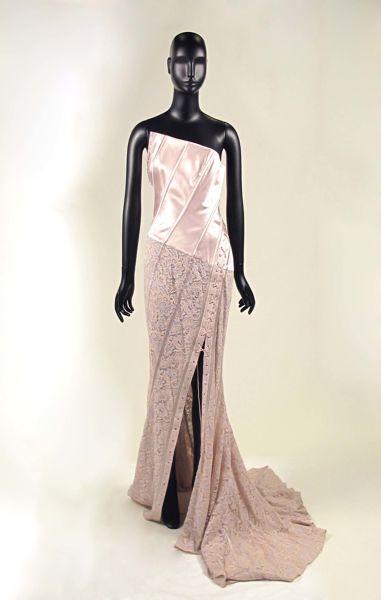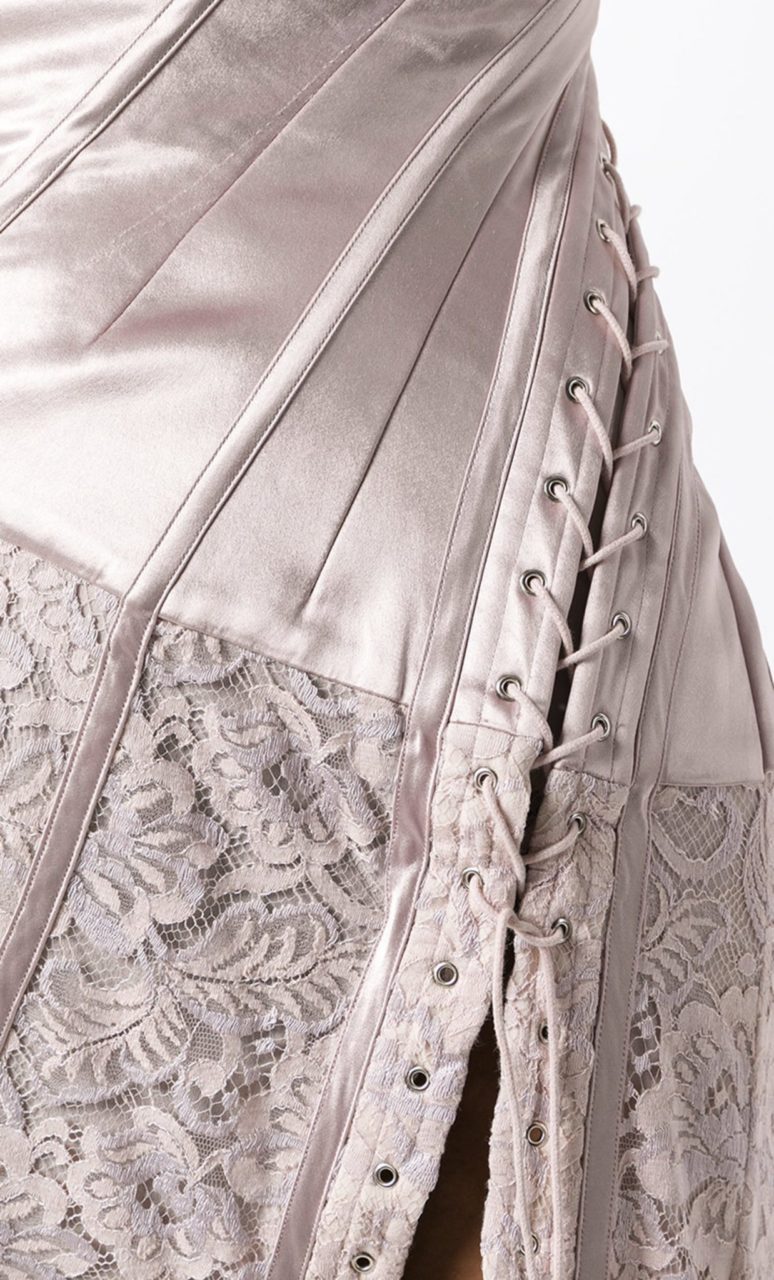Amidst a collection of punk-rock glam and gingham prints, this lace and silk asymmetrical gown was a breath of romance and innocence. Galliano was able to convey a more playful side of sexuality behind a façade of sophisticated refinement. The asymmetrical bias-cut silk, daring slit, and body-hugging boning make this champagne-pink, punk rock inspired evening gown sexy, intriguing, and memorable.
About the Look
T
his champagne-pink evening dress was designed by John Galliano in 2000. The use of sheer lace, corsetry closure, and boning create a sense of intimacy. Yet considering its diagonal seams, asymmetrical neckline, and thigh-high slit, this garment expresses anything except delicacy.
The silk bodice of the garment features an adjustable one-shoulder neckline, hugs the body around the waist, and meets the cotton lace skirt diagonally at the hip, leading into an elegant train. With the turn of the century bringing high expectations, Galliano proved capable, raising his standards as well as leg-slits. In figure 1, the model wears the gown unlaced until the end of the bodice, revealing the length of her legs. Attractive as it may be unlaced, it can be laced further down by the wearer if desired (Fig. 2). The grommets along the neck allow for a ribbon to be tied from front to back as an optional strap, as seen in detail in figure 3.
On the runway, the gown was paired with matching ankle booties, smoky eye shadow, and a textured up-do (Fig. 2). The punk rock style of the collection can be seen in the runway presentation by clicking the video to the right; this look appears at 4:27. Galliano was able to convey a playful side of sexuality by incorporating deconstruction and imperfection, which is paralleled in a similar look he designed for Spring/Summer 2000 Dior (Fig. 4).
Fig. 1 - John Galliano (British, 1960-). Evening Gown, Spring/Summer 2000 RTW. Source: William Vintage
Video of the 2000 runway presentation. Source: YouTube
Fig. 2 - John Galliano (British, 1960-). Evening dress, Spring/Summer 2000 RTW. Silk, metal, and cotton. Paris. Photo: JB Villareal. Source: Vogue
Fig. 3 - John Galliano (British, 1960-). Evening dress, Spring/Summer 2000 RTW. Source: 1stdibs
Fig. 4 - Galliano for Dior (British, 1960-). Model no. 39, Spring/Summer 2000. Silk, paint, lacquer, metal, viscose, nylon, leather. Melbourne: The National Gallery of Victoria, 2002.417.a-d. Presented through the NGV Foundation by Norma and Stuart Leslie, Governors, 2002. Source: NGV
John Galliano (British, 1960-). Evening dress, Spring/Summer 2000 Ready-to-Wear. Silk, metal, and cotton. New York: The Metropolitan Museum of Art, 2016.54. Purchase, Various Donors, by exchange, 2015. Source: The Metropolitan Museum of Art
About the context
In 1996, John Galliano moved from Givenchy to lead the house of Christian Dior. Simultaneously, he managed a line under his own name and designed twice as many innovative collections every season. Galliano hit the ground running with his first show as creative director at Dior. In Galliano (1997), Colin McDowell wrote of the experience: “The Galliano for Dior couture shows at the Grand Hotel had been spectacular” (38). A graduate from Central Saint Martins, Galliano’s ready-to-wear and haute couture collections were liked by many and he received high praise for his unique ability to tell stories through his work. His aesthetic often focused on seduction or historical references. In Gods and Kings: The Rise and Fall of Alexander McQueen and John Galliano (2015), author Dana Thomas discusses how his debut with Dior was impressive:
“Fashion had never seen such opulence, extravagance, or boldness of presentation and design. It was obvious that money was no object – that Galliano had no constraints creatively or financially. The result was couture on steroids, and it left guests gasping and reeling… As the crowd erupted in applause, Galliano took his curtain call.” (231)
His influence on the fashion industry skyrocketed and other houses were beginning to journey to the past as he was too. In The History of Modern Fashion (2015), authors Daniel James Cole and Nancy Deihl write that John Galliano’s designs were among some of the most imitated looks in the fashion industry during the time, especially his bias-cut silk dresses inspired by the 1930s (395). This champagne-pink Galliano evening gown from Spring/Summer 2000 is an excellent example of his iconic technique. The asymmetrical corset twists around the torso, highlighting the model’s curves. As seen in figure 6, the lace cotton panels of the skirt lay behind in a three-point train, with seams that wrap around to emphasize the bias-cut detail. Cole and Deihl explain that Galliano’s use of lace and bias cuts is typical of his design for his own brand and for Dior: “In 1997 he interpreted Christian Dior’s Bar suit with a peplum jacket made of leather lace over a short bias cut skirt” (400). The daring thigh high slit is made possible by the corset style closure that fastens from the side back to the side front, with ribbon lacing through the trail of grommets, as seen in figure 5. Yet, despite how romantic and delicate this garment appears at first glance, it is anything but.
Fig. 5 - John Galliano (British, 1960-). Evening Gown, Spring/ Spring 2000 RTW. Source: William Vintage
Fig. 6 - John Galliano (British, 1960-). Bella Hadid in Galliano, 2017. Photo: Getty Images. Source: Harper's Bazaar
Fig. 7 - John Galliano (British, 1960-). Look 31, Fall 2000 RTW. Photo: JB Villareal. Model: Kiara Kabukuru. Source: Vogue
Fig. 8 - Galliano for Dior (British, 1960-). Look 31, Fall 2000 RTW. Photo: JB Villareal. Model: Debbie Deitering. Source: Vogue
Every collection has a story, and though this collection played on the idea of love and innocence, it was more punk-rock than this gown suggests. Vogue Runway described Galliano’s Spring 2000 Ready-to-Wear Collection, writing:
“Galliano’s take on … the beginning of rock. Gingham prints, floral appliqués and extravagant pink volumes alternated with punk and hip-hop inspired getups: combat boots, bondage straps … and slashed dresses.”
This concept of deconstruction can be seen in Galliano’s choice to throw the entire garment off balance, which he accomplished gracefully. When styled with ankle booties, smokey eye shadow, and a funky up-do, you get the sense of the rest of the lineup. It was a musical rundown of the century, unexpected, but well-executed. McDowell discusses in Galliano how the designer and his team were well known for spending considerable amounts of time doing background research to accurately achieve the concept he has in mind, for Givenchy, Dior, and his own label (46). In doing so, many looks across the design houses resembled each other as Galliano juggled 2 collections at once, in theory making his work more recognizable by style and silhouette. An example of this is a gown Galliano designed for Fall 2000 (Fig. 7), which resembles the corseted evening dress in both color and cut.
Unfortunately for Galliano, he was criticized on the release of his controversial “hobo” inspired collection for Dior in Fall 2000. The garment in figure 8 relates to the champagne pink silk evening dress in that it is also bias-cut silk, yet it lacks all the sophistication of that dress. Newsprint printed underwear worn by the model is paired with an unappealing brown drape over the shoulder that vaguely resembles a garbage bag. In Gods and Kings, Thomas describes the reaction: “There was little applause during the show and only a polite clapping at the end as Galliano walked down the runway… everything about the show seemed outsize and quite unhinged” (298). As Thomas’s book title suggests, Galliano’s reign does somewhat come to an end. After derogatory statements John Galliano made in 2011, he was dismissed from Dior. In attempt to make a successful comeback, he is now the creative director of Maison Margiela, but the impression he made on late 20th-century fashion is not forgotten.
Its Afterlife
The evening dress has since been featured in exhibitions at both The Metropolitan Museum of Art and The Museum at FIT. The champagne pink color of the garment prompted its inclusion in “Pink: The History of Punk, Pretty, Powerful Color” at MFIT. The title of the exhibition accurately defined Galliano’s aesthetic for his Spring/Summer 2000 collection that the garment was designed for. Perhaps the “prettiest” gown of the entire lineup, it still had punk-rock roots, and radiated female empowerment.
The gown has proven to be a timeless design, reappearing in the spotlight almost 20 years later. Bella Hadid, world famous supermodel, glided down the Spanish Steps in Rome wearing vintage Galliano in 2017 as seen in the video below (0:22). Her campaign for Bvlgari Goldea Roman Night perfume received a considerable amount of press coverage, as did the sexy, silk gown (Fig. 9).
Video of Bella Hadid for Bvlgari in vintage Galliano (2017). Source: YouTube
Fig. 9 - John Galliano (British, 1960-). Evening Gown, Spring/ Summer 2000 RTW. Silk, metal, and cotton. Source: Fashion Sizzle
References:
- Cole, Daniel James, and Nancy Deihl. The History of Modern Fashion From 1850. London: Laurence King Publishing, 2015. http://www.worldcat.org/oclc/932219920.
- “John Galliano | Evening Dress | British | The Met.” The Metropolitan Museum of Art, i.e. The Met Museum. Accessed March 6, 2019. https://www.metmuseum.org/art/collection/search/693849.
- “John Galliano Spring 2000 Ready-to-Wear Collection – Vogue.” Vogue. Accessed March 6, 2019. https://www.vogue.com/fashion-shows/spring-2000-ready-to-wear/john-galliano.
- McDowell, Colin. Galliano. New York: Rizzoli, 1998. http://www.worldcat.org/oclc/75808765.
- Thomas, Dana. Gods and Kings: The Rise and Fall of Alexander McQueen and John Galliano. New York: Penguin Press, 2015. http://www.worldcat.org/oclc/908517499.



















